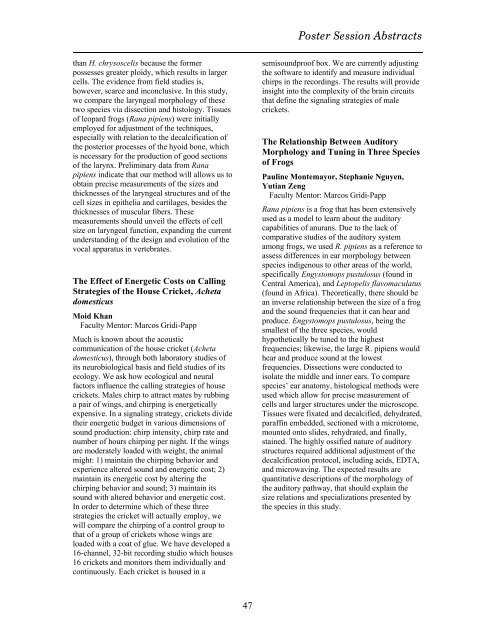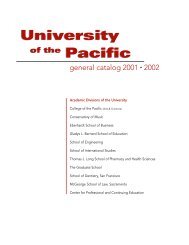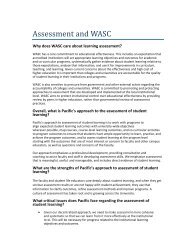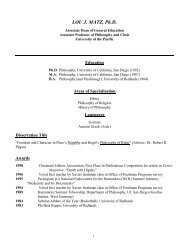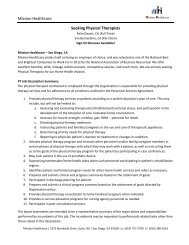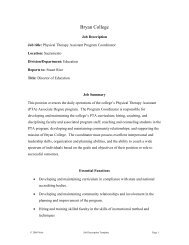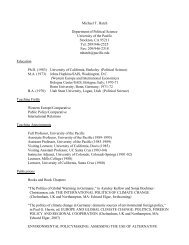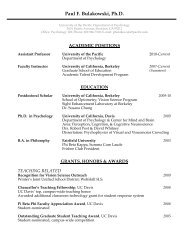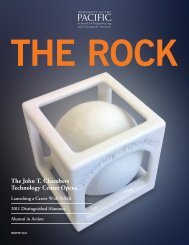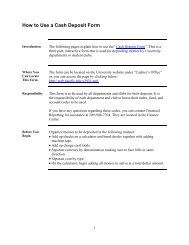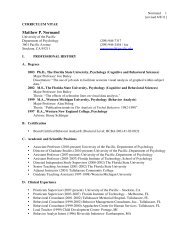purcc 2012 - University of the Pacific
purcc 2012 - University of the Pacific
purcc 2012 - University of the Pacific
You also want an ePaper? Increase the reach of your titles
YUMPU automatically turns print PDFs into web optimized ePapers that Google loves.
Poster Session Abstracts<br />
than H. chrysoscelis because <strong>the</strong> former<br />
possesses greater ploidy, which results in larger<br />
cells. The evidence from field studies is,<br />
however, scarce and inconclusive. In this study,<br />
we compare <strong>the</strong> laryngeal morphology <strong>of</strong> <strong>the</strong>se<br />
two species via dissection and histology. Tissues<br />
<strong>of</strong> leopard frogs (Rana pipiens) were initially<br />
employed for adjustment <strong>of</strong> <strong>the</strong> techniques,<br />
especially with relation to <strong>the</strong> decalcification <strong>of</strong><br />
<strong>the</strong> posterior processes <strong>of</strong> <strong>the</strong> hyoid bone, which<br />
is necessary for <strong>the</strong> production <strong>of</strong> good sections<br />
<strong>of</strong> <strong>the</strong> larynx. Preliminary data from Rana<br />
pipiens indicate that our method will allows us to<br />
obtain precise measurements <strong>of</strong> <strong>the</strong> sizes and<br />
thicknesses <strong>of</strong> <strong>the</strong> laryngeal structures and <strong>of</strong> <strong>the</strong><br />
cell sizes in epi<strong>the</strong>lia and cartilages, besides <strong>the</strong><br />
thicknesses <strong>of</strong> muscular fibers. These<br />
measurements should unveil <strong>the</strong> effects <strong>of</strong> cell<br />
size on laryngeal function, expanding <strong>the</strong> current<br />
understanding <strong>of</strong> <strong>the</strong> design and evolution <strong>of</strong> <strong>the</strong><br />
vocal apparatus in vertebrates.<br />
The Effect <strong>of</strong> Energetic Costs on Calling<br />
Strategies <strong>of</strong> <strong>the</strong> House Cricket, Acheta<br />
domesticus<br />
Moid Khan<br />
Faculty Mentor: Marcos Gridi-Papp<br />
Much is known about <strong>the</strong> acoustic<br />
communication <strong>of</strong> <strong>the</strong> house cricket (Acheta<br />
domesticus), through both laboratory studies <strong>of</strong><br />
its neurobiological basis and field studies <strong>of</strong> its<br />
ecology. We ask how ecological and neural<br />
factors influence <strong>the</strong> calling strategies <strong>of</strong> house<br />
crickets. Males chirp to attract mates by rubbing<br />
a pair <strong>of</strong> wings, and chirping is energetically<br />
expensive. In a signaling strategy, crickets divide<br />
<strong>the</strong>ir energetic budget in various dimensions <strong>of</strong><br />
sound production: chirp intensity, chirp rate and<br />
number <strong>of</strong> hours chirping per night. If <strong>the</strong> wings<br />
are moderately loaded with weight, <strong>the</strong> animal<br />
might: 1) maintain <strong>the</strong> chirping behavior and<br />
experience altered sound and energetic cost; 2)<br />
maintain its energetic cost by altering <strong>the</strong><br />
chirping behavior and sound; 3) maintain its<br />
sound with altered behavior and energetic cost.<br />
In order to determine which <strong>of</strong> <strong>the</strong>se three<br />
strategies <strong>the</strong> cricket will actually employ, we<br />
will compare <strong>the</strong> chirping <strong>of</strong> a control group to<br />
that <strong>of</strong> a group <strong>of</strong> crickets whose wings are<br />
loaded with a coat <strong>of</strong> glue. We have developed a<br />
16-channel, 32-bit recording studio which houses<br />
16 crickets and monitors <strong>the</strong>m individually and<br />
continuously. Each cricket is housed in a<br />
semisoundpro<strong>of</strong> box. We are currently adjusting<br />
<strong>the</strong> s<strong>of</strong>tware to identify and measure individual<br />
chirps in <strong>the</strong> recordings. The results will provide<br />
insight into <strong>the</strong> complexity <strong>of</strong> <strong>the</strong> brain circuits<br />
that define <strong>the</strong> signaling strategies <strong>of</strong> male<br />
crickets.<br />
The Relationship Between Auditory<br />
Morphology and Tuning in Three Species<br />
<strong>of</strong> Frogs<br />
Pauline Montemayor, Stephanie Nguyen,<br />
Yutian Zeng<br />
Faculty Mentor: Marcos Gridi-Papp<br />
Rana pipiens is a frog that has been extensively<br />
used as a model to learn about <strong>the</strong> auditory<br />
capabilities <strong>of</strong> anurans. Due to <strong>the</strong> lack <strong>of</strong><br />
comparative studies <strong>of</strong> <strong>the</strong> auditory system<br />
among frogs, we used R. pipiens as a reference to<br />
assess differences in ear morphology between<br />
species indigenous to o<strong>the</strong>r areas <strong>of</strong> <strong>the</strong> world,<br />
specifically Engystomops pustulosus (found in<br />
Central America), and Leptopelis flavomaculatus<br />
(found in Africa). Theoretically, <strong>the</strong>re should be<br />
an inverse relationship between <strong>the</strong> size <strong>of</strong> a frog<br />
and <strong>the</strong> sound frequencies that it can hear and<br />
produce. Engystomops pustulosus, being <strong>the</strong><br />
smallest <strong>of</strong> <strong>the</strong> three species, would<br />
hypo<strong>the</strong>tically be tuned to <strong>the</strong> highest<br />
frequencies; likewise, <strong>the</strong> large R. pipiens would<br />
hear and produce sound at <strong>the</strong> lowest<br />
frequencies. Dissections were conducted to<br />
isolate <strong>the</strong> middle and inner ears. To compare<br />
species’ ear anatomy, histological methods were<br />
used which allow for precise measurement <strong>of</strong><br />
cells and larger structures under <strong>the</strong> microscope.<br />
Tissues were fixated and decalcified, dehydrated,<br />
paraffin embedded, sectioned with a microtome,<br />
mounted onto slides, rehydrated, and finally,<br />
stained. The highly ossified nature <strong>of</strong> auditory<br />
structures required additional adjustment <strong>of</strong> <strong>the</strong><br />
decalcification protocol, including acids, EDTA,<br />
and microwaving. The expected results are<br />
quantitative descriptions <strong>of</strong> <strong>the</strong> morphology <strong>of</strong><br />
<strong>the</strong> auditory pathway, that should explain <strong>the</strong><br />
size relations and specializations presented by<br />
<strong>the</strong> species in this study.<br />
47


